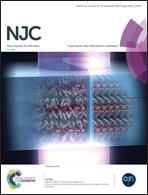Portraying the role of halo ligands and the auxiliary part of ligands of mononuclear manganese(iii)-Schiff base complexes in catalyzing phospho–ester bond hydrolysis†
Abstract
Four mononucleating Schiff base ligands, namely HL1, HL2, HL3 and HL4, were prepared via condensation between 2-hydroxybenzaldehyde and 2-morpholinoethanamine, 2-(piperazin-1-yl)ethanamine, 2-(piperidin-1-yl)ethanamine and 2-(pyrrolidin-1-yl)ethanamine, respectively. Then, seven mononuclear manganese(III) complexes were synthesized using the above-mentioned ligands. Complexes 1–3 were prepared with ligand HL1 by using chloride, bromide and iodide salts of manganese(II), respectively. On the other hand, complexes 4, 5, 6 and 7 were prepared by reaction of manganese chloride followed by sodium thiocyanate with ligands HL2, HL3, HL4, and HL1, respectively. All the complexes were characterized by using the usual physicochemical techniques and their solid state structures were obtained from single crystal X-ray analysis. The phosphatase-like activity of these complexes was studied in a 97.5% (v/v) N,N-dimethylformamide–water mixture using the disodium salt of 4-nitrophenylphosphate (4-NPP) as a model substrate to evaluate the role of halo-anions and the auxiliary part of the ligand backbone in the phosphatase like activity. Detailed experimental findings proved that complex 2 is the most active catalyst among all seven complexes and the complex bearing a morpholine ring is the most active catalyst among complexes 4–7.



 Please wait while we load your content...
Please wait while we load your content...